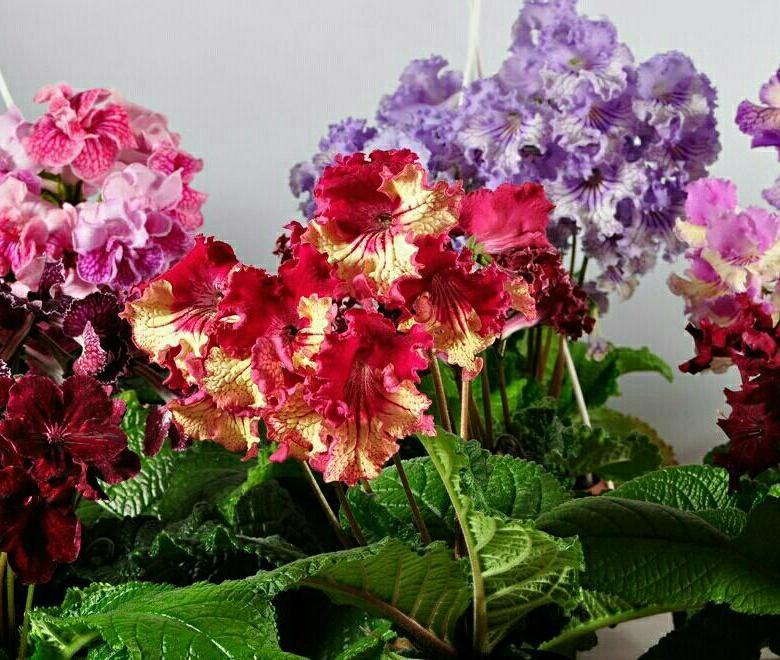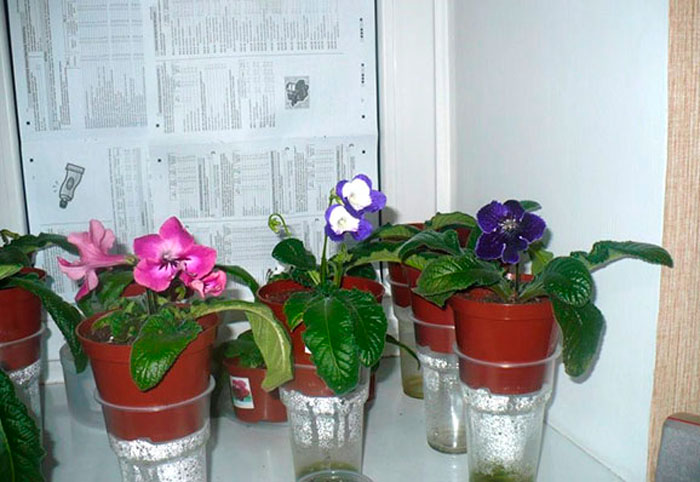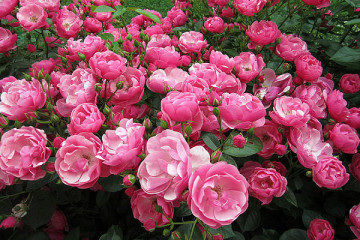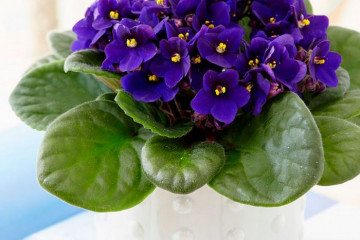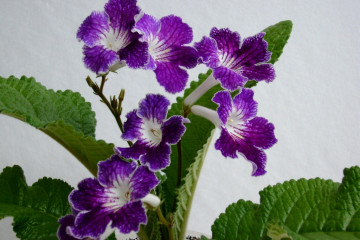Streptocarpus DS 2080 and other varieties of Dimetris selection
Content:
Streptocarpus, or in the common people, streps is one of the most beautiful indoor flowers loved by breeders. The variety and annual renewal of the list of varieties turns the plant into a real collector's item.
The history of the appearance and general characteristics of streptocarpus breeding Dimetris
The birthplace of streptocarpus is the island of Madagascar. In 1818, botanist Jay Bowie discovered an unusual plant, was able to preserve and transfer the seeds to the botanical greenhouses in London. The flower was originally named Didimocarpus rexii, but a decade later it was renamed Streptocarpus rexii. It was this flower that became the basis for all modern hybrids.
Common plant characteristics:
- belongs to the Gesneriev family, unpretentious in care;
- inflorescences consist of several large buds;
- the base of the leaves is a wide rosette, which is attached to the stem at the very bottom.
In the wild, streptocarpus prefer a humid and warm climate. Growth halo - near water bodies. In rare cases, the plant is found in mountainous areas.
Description of popular varieties of streptocarpus Dimetris
The main types of streptocarpus:
- Rocky. Prefers stony soil, resistant to drought and UV rays. The root system is dense, twisted, stiff. The foliage is small with villi, the flowers are small, have a pastel purple color.
- Royal. Preferences - subtropical climate, shaded areas. The root system is branched, the foliage is elongated and long. The flowers are large, up to 30 cm, have a bright purple color.
- Wendland. Prefers a temperate humid climate. The leaves are wide and long, up to 1 m long. The flowering period is long. On a flower with one root system, there are up to 19-20 large purple inflorescences.
DS 2080
Streptocarpus ds 2080 has double large flowers of a rich purple hue; towards the middle, the color turns into white. A feature of the variety is the central part, which consists of 3, not 4 petals.
DS 1920
Streptocarpus 1920 has large, curved, wavy petals in a rich fuchsia shade. In the middle of the petal, there are splashes of white and pale pink flowers.
DS 2059
The variety has 2 levels of petals, each with a different color. The lower tier is a juicy yellow shade with a red mesh. The upper petals are burgundy red. The variety is profusely blooming, the texture of the petal is semi-double.
DS 1726
Inflorescences of Streptocarpus 1726 have a dense terry covering of petals. The color ranges from light pink to deep dark shade. The socket does not thicken. The size of the flower is from 8 to 10 cm.
DS 1931
The flower has wavy semi-double petals. The colors range from pink at the base to dark crimson edging. On the lower petal there are reticular blotches of white, the rest of the flower is monochrome.
DS Margarita
This straps has large, up to 9-10 cm, buds. The petals are velvety, in the form of ruffles.The color of the petals is divided into levels: the lower tier is rich crimson, the upper tier is light pink. In sunlight, the flower gets orange highlights. Inflorescences are strong, do not thicken.
DS Eternity
This DS streptocarpus is terracotta red. The edges of the petals are burgundy, almost black. The texture of the flower is terry thick. The size of the bud reaches 9 cm.
DS Ezhkin cat
This variety of streps has large artsy branches. Terry petals, painted in a black and purple hue. They have splashes of white and purple tones. The shape of the petal is pointed, reminiscent of a wasp.
DS Midnight Poison
The name translated means "midnight poison". Poisonous lilac color of petals with a white mesh fully corresponds to the name of the variety. The size of the bud reaches 9-10 cm, the Peduncle has a strong base.
DS Fire
This straps has ruffle-shaped petals, their texture is thick, terry. The color of the flower is burgundy with splashes of red and purple. The lower tier of petals is covered with white spots. The bud is large, 8-9 cm. The flower has a rich aroma.
Planting streptocarpus and soil composition
It is customary to plant straps for seedlings in early February. Rushing to sow will not work. Procedure:
- A container is prepared for seedlings, the bottom of which is covered with drainage.
- Soil is poured on top, and the finished substrate is moistened.
- Streptocarpus seeds are scattered over the soil, without deepening.
- The container is covered with polyethylene to create a greenhouse effect.
Soil for streps should have a saline pH of 5.0 and consist of the following elements (calculated as ml / l):
- nitrogen - 150-160;
- phosphorus - not less than 250;
- potassium - 350-360.
The general characteristic of the soil substrate is loose, air and water permeable.
Streptocarpus care at home
With proper care, streptocarpus can bloom almost all year, starting not only in August. To achieve this effect, it is necessary to follow the rules of watering, lighting, feeding and temperature conditions.
Watering
Special attention should be paid to the quality of flower hydration. Water for irrigation should be soft, settled or thawed, the optimum temperature is slightly above room temperature. Excess moisture is detrimental to the flower.
Watering is done moderately, after the middle layer of the soil has dried. When moistening the plant, water should not fall on the petals and leaves. The best watering method is in a pan of water. After 15 minutes, excess moisture is poured out of it.
Top dressing
From spring to the end of autumn, streptocarpus needs top dressing. For this, nitrogen and potash fertilizers are used, alternating them. Top dressing is applied to wet soil. The dosage is calculated according to the directions on the package, but the amount is halved. For young, recently rooted plants, nitrogenous types of fertilizing are considered the most suitable.
Lighting and temperature
The daylight hours of the streps should be 12-14 hours long. The plant prefers bright and diffused lighting. During the period of the year with short daylight hours, it is necessary to use phytolamps. The ideal location for the flower is the windows facing east and west.
Streptocarus is a thermophilic flower. The average temperature in the room all year round should be + 15-18 degrees for common species and + 18-20 degrees for hybrids. Streps feel most comfortable in indoor conditions.Any draft can lead to illness and death of the flower.
How streptocarpus reproduces
Streps reproduces in two ways: by seeds and by a vegetative method. The simplest option is to divide adult bushes into 3 parts, each of which should be planted in suitable soil up to the root collar. Places of cuts are sprinkled with crushed coal. If propagation is carried out using a leaf, it is planted in the soil, deepening by 10 mm. The container is covered with glass or foil to achieve a greenhouse effect. The sheet is ventilated daily. The temperature of the content is +24 degrees.
The seeds of the plant are prepared for planting in April. The technique is described above, in the "Landing" section. After the emergence of seedlings, a dive is carried out twice.
Major pests and common diseases
Streptocarpus are threatened by 4 main types of problems:
- Gray rot. It appears on the leaves in the form of brownish spots, brownish bloom and leads to rotting. Method of treatment - treatment of the plant with a solution of copper oxychloride 0.5%.
- Powdery mildew. The leaves and stem are covered with a whitish bloom and spots. The method of disposal is to treat the affected areas with a fungicide every 10 days. Continue until the manifestations of the disease disappear completely.
- Thrips. Only the stem lends itself to treatment for these insects. The foliage and flowers are cut, the cut sites are covered with Akarin.
- Aphid. These small insects will leave the plant only after treatment with insecticides and soapy water. A sick flower must be isolated from healthy fellows.
Streptocarpus, regardless of the variety, will become the favorite of any grower. Proper care, timely transplantation and treatment will provide the plant with a long period of active flowering, and the appearance of the streps will improve the owner's mood.

